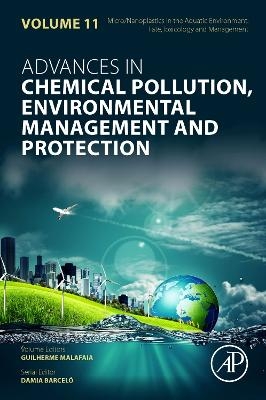
Micro/Nanoplastics in the Aquatic Environment: Fate, Toxicology and Management
Academic Press Inc (Verlag)
978-0-443-23873-4 (ISBN)
Dr. Malafaia (Guilherme) is a Department of Biological Sciences Professor at Goiano Federal Institute of Education, Science, and Technology (Goiás State, Brazil). He received a bachelor's and master's degree from the Federal University of Ouro Preto (Brazil) and a doctorate from the Federal University of Goiás (Brazil). Atualmente, têm sete estágio de pós-doutorado em universidades do Brasil, Bangladesh, Egito e India, all related to Environmental and Biological Sciences. He coordinates the Laboratory of Toxicology Applied to the Environment, focusing on the ecotoxicological assessment of emerging pollutants, including micro(nano)plastics, nanomaterials, nanofibers, pesticides, drug residues, etc. The ongoing research projects in his lab use different animal species as model systems (e.g., mice, zebrafish, guppy, Amazon turtle, tadpole, Japanese quails, mosquito larvae, earthworms, and dragonfly larvae, in addition to aquatic and native plants from Brazilian Cerrado). He has published over 315 journal papers and several books. In addition, he has served as a reviewer for more than 170 international journals. He is an advisor for scientific initiation (undergraduate students), master's, doctorate, and post-doctoral internships. He is part of the Editorial Board of renowned international journals, such as the Journal of Hazardous Materials, Science of The Total Environment, Aquatic Toxicology, Journal of Hazardous Materials Advances, Environmental Sciences Europe, Water Emerging Contaminants & Nanoplastics, Frontiers in Marine Science, Frontiers in Physiology, among others.
1: Plastic pollution in the aquatic ecosystem: an emerging threat and its mechanisms.
Mir Mohammad Ali, Paola Reale, Md. Saiful Islam, Md Asaduzzaman, Mahbub Alam, and Md. Mostafizur Rahman
2: Behavior of micro(nano)plastics in the aquatic environment and influencing factors.
Pazhamthavalathil Anil Athulya, Natarajan Chandrasekaran, John Thomas, and Amitava Mukherjee
3: Analysis and distribution characteristics of micro(nano)plastics in the water environment.
Bing Han, Xinglei Wang, Jie Cao, and Xuetao Guo
4: Interactions between microplastics and primary producers in aquatic ecosystems.
Gabriela Kalcíková, Ula Rozman, and Ludmila Polechonska
5: Release of micro(nano)plastics from face masks into the marine environment: measurements and ecotoxicity.
Gabriel E. De-la-Torre, Carlos Ivan Pizarro-Ortega, Diana Carolina Dioses-Salinas, Damarisch Fernanda Urizar Garfias Reyes, Melisa D. Fernández Severini, Ana D. Forero López, Md. Refat Rakib, and Sina Dobaradaran.
6: The ecology of microbial communities on microplastics.
Jie Wang
7: Metals on microplastics and their environmental consequences in freshwater ecosystems.
Rocío S. Pazos, Javier Amalvy, and Nora Gómeza
8: Effect of biofilm attachment on the fate of microplastics in the aquatic environment.
Jia Jia, E Zhao, Xiong Xiong, and Chenxi Wu
9: Micro(nano)plastic pollution in the global mangrove ecosystem: a comprehensive review on the sources, fates, and effects.
Farah Noshin Chowdhury, Maisha Binte Sultan, and Md. Mostafizur Rahman
10: Effects of microplastics on amphibian performance and survival: current knowledge and research gaps.
Naiara López Rojo, Alberto Alonso, Luz Boyero, and Jaime Bosch
11: Microplastics in fishes: Occurrence, impacts, and future perspectives.
Mir Mohammad Ali, A.S. Shafiuddin Ahmed, Md. Saiful Islam, Shahrina Akhtar, and Md. Mostafizur Rahman
12: Distribution, fate, and trophic transfer of micro(nano)plastics in aquatic and land snails.
Cândido Carvalho Rodrigues, Raquel Fernanda Salla, and Thiago Lopes Rocha
13: Microplastics in mariculture: Source, fate, and management.
Jingmin Zhu, Jiana Li, Yifan Zheng, and Huahong Shi
| Erscheint lt. Verlag | 22.3.2024 |
|---|---|
| Reihe/Serie | Advances in Chemical Pollution, Environmental Management and Protection |
| Mitarbeit |
Herausgeber (Serie): Guilherme Malafaia |
| Verlagsort | San Diego |
| Sprache | englisch |
| Maße | 152 x 229 mm |
| Gewicht | 720 g |
| Themenwelt | Naturwissenschaften ► Biologie ► Ökologie / Naturschutz |
| Technik ► Umwelttechnik / Biotechnologie | |
| ISBN-10 | 0-443-23873-1 / 0443238731 |
| ISBN-13 | 978-0-443-23873-4 / 9780443238734 |
| Zustand | Neuware |
| Haben Sie eine Frage zum Produkt? |
aus dem Bereich


